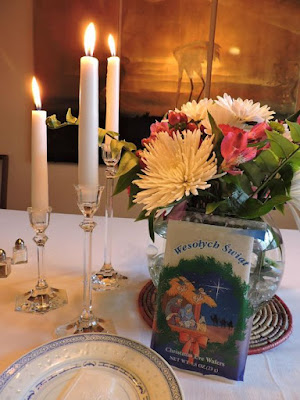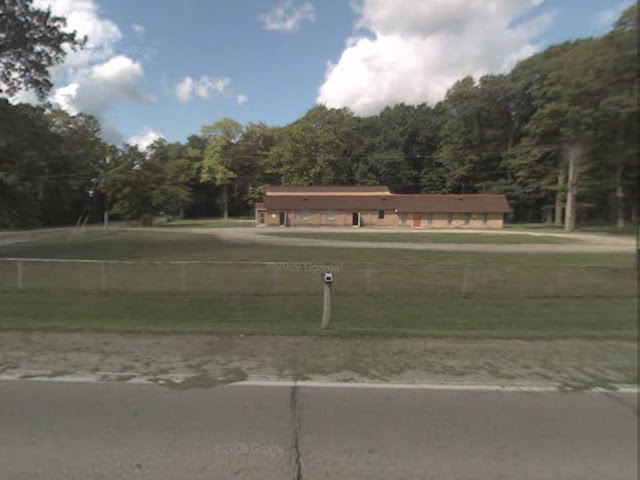Every Christmas we went to our Polish grandmother's house on Florida Street in Detroit on Christmas Eve. It was an annual tradition. We would all be bundled up in heavy coats with scarves and mittens. There always seemed to be snow. One of the babies was always sick--that too, seemed to be part of the tradition.
As we walked in, carrying bundles of gifts, my first memory was of seeing the Christmas tree. Uncle Ed and Aunt Sophie had the greatest tree. It seemed to have hundreds of lights (the big, brightly colored ones, not the little Italian ones of today).
 |
A sampling of ornaments--some Polish, on our Christmas tree.
Can you spot the Polish dancers? |
There were unusual ornaments--angels with feathers, birds with brilliant tails, and lights filled with colored fluid that would bubble, as they got warm. Underneath the tree was a beautiful Nativity scene with intricate figurines.
 |
| I took this picture in a storefront in the Italian section of Philadelphia. |
The heat inside the house was intense. It was like opening an oven door, but, ah, the wonderful smells. The smell of the Christmas tree mixed with those of sauerkraut, mushrooms, stewed fruit, and frying butter. Babci (our grandmother), Aunt Sophie, and other aunts were in the tiny kitchen cooking. Mother would join them in the kitchen as the older kids hung by hoping for a sample. Uncle Ed would let us go down into the basement to get a soda--you had to duck your head going down, even when you were little. Cream soda was the best--we never had it at home.
It seemed like the aunts and uncles and cousins would arrive in waves: Uncle John and Aunt Hattie and Cousin Marie. Uncle Mike and Aunt Louise with cousins Buddy, Frank, Fred, and John, and Uncle Vince with Aunt Mary and Cousin Tom. Each wave with their own bundles, shaking off snow, and taking off coats and hats and gloves. Presents were whisked away. It would be hours before we saw them.
Then it was time for dinner. I always thought there was supposed to be an odd number of courses, but others have told me that is should have been even. Mushroom soup with boiled potatoes. Pierogies with potatoes and cheese or sauerkraut and mushrooms. Kasha. Pickled herring. Stewed fruit. Everything was delicious. There was also always an empty place setting at the table in case an unexpected guest should arrive recalling the biblical tale of Joseph and Mary, when they found no room at the inn.
 |
| Oplatek (Wafer) on our table. |
In the center of the table was the oplatek, a rectangular piece of wafer imprinted with a religious scene. Everyone at the table shared the wafer. We wished each other health, wealth, and happiness and often a special wish.

Festive Christmas table at our house.
My favorite memory of Christmas was when my cousin John suddenly appeared during dinner on Christmas Eve. He was in Vietnam during the war and was not expected home. Of course, there was a place for him at the table! All of the aunts and even some of the uncles, cried.
After dinner, we would sing Christmas carols and eat Christmas sweets. Our father was a great singer of Polish Christmas carols. He and Uncle John usually led the singing. Dad had a small, thick, green book with all of the Polish kolendy (Christmas carols) in them. Dad knew the lyrics and the melodies by heart. I always wondered where he learned them. Babcia, with her high voice, would sing with the uncles. Her voice was such a contrast with the low voices of dad and Uncle John. If dad and the uncles had enough Christmas "spirit”, they would go outside and serenade the neighbors with carols.
 |
A selection of Christmas cookies I made in 2022. Not as many as usual. |
 |
| Some traditional Polish treats I've made for Christmas. |
While we were singing, a couple of the uncles would disappear and rustling sounds could be heard above us. All of a sudden, a ringing bell could be heard outside. The little kids all knew what that meant--Santa Claus was here! Those rustling sounds must have been reindeer on the roof!
Santa always had bags and bags of presents. One of the kids was chosen to help Santa distribute gifts. More bags of gifts appeared from the back of the kitchen. There were toys galore. I think each aunt and uncle would try to outdo each other giving gifts. You knew childhood was over when, instead of toys or games, you received clothes as your Christmas gift! Babci always gave us three silver dollars--our mother saved them for us for over forty years.
After the gifts were opened it was time for treats. I do not know why, but Aunt Sophie served us spumoni ice cream, but was always a part of Christmas. It was a rich Italian ice cream with almond flavoring and pistachio nuts and candied fruit. We ate it along with poppy seed and nut filled coffeecake. Aunt Hattie would make pastries called chrusciki. We called them angel wings. They were as light as a feather!
 |
| Homemade Spumoni ice cream cake. |
We almost never made it to Midnight Mass. I do not know how we ever made it home. We must have been re-bundled up, the presents loaded, treats for Christmas Day wrapped up, and all of us finally on our way home in one of Dad's Desotos.
Mom and Dad took care of everything--it a very big chore for them with five children, as they still had to play "Santa" for us at our house on Christmas morning! It was only the start of a hectic season of visiting family and friends and, in turn, having friends and family at our house.
These are my memories. There are other memories of our Polish Christmas, but this is what I leave to my brother and sisters, nieces and nephews, their children, and my friends. It is a memory of a simpler time, when grievances were forgotten, and wishes were exchanged--for a better year, a better life. It was an acknowledgment that, after all, we were family--and family was important!




























